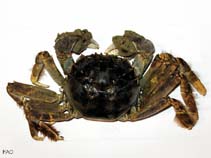Eriocheir sinensis Milne-Edwards, 1853
Chinese mitten crab| Native range | All suitable habitat | Point map | Year 2050 |

|
| This map was computer-generated and has not yet been reviewed. |
| Eriocheir sinensis AquaMaps Data sources: GBIF OBIS |
Classification / Names ชื่อสามัญ | ชื่อพ้อง | CoL | ITIS | WoRMS
Malacostraca | Decapoda | Varunidae
Environment: milieu / climate zone / ระดับความลึก / distribution range นิเวศวิทยา
; น้ำจืด; กร่อย; ระดับความลึก 0 - 25 m (อ้างอิง 81172). Temperate; 5°C - 27°C (อ้างอิง 8003); 44°N - 21°N, 112°E - 135°E
Distribution ประเทศต่างๆ | พื้นที่จำแนกตาม FAO | ระบบนิเวศหลายระบบ | การปรากฏขึ้น,การเกิดขึ้น,พบ | การแนะนำ
Northwest Pacific: Native from Valdivostok Russia, to the west coast of North Korea south to Hong Kong, China. Introduced to central and western Europe.
Length at first maturity / ขนาด / Weight / Age
วัยเจริญพันธุ์: Lm ? range ? - ? cm Max length : 7.5 cm CW เพศผู้/กระเทย; (อ้างอิง 3159)
Life cycle and mating behavior วัยเจริญพันธุ์ | การสืบพันธุ์ | การวางไข่ | Eggs | ความดกของไข่ | Larvae
Main reference
อ้างอิง | ผู้ประสานงาน | ผู้ร่วมมือ
Ray, G.L. 2005 Invasive Animal Species in Marine and Estuarine Environments: Biology and Ecology. Aquatic Nuisance Species Research Program. (อ้างอิง 3159)
IUCN Red List Status
(อ้างอิง 130435: Version 2025-1)
CITES status (อ้างอิง 108899)
CMS (อ้างอิง 116361)
Threat to humans
Human uses
การประมง: การค้า
FAO - การเพาะเลี้ยงสัตว์น้ำ: production, species profile; การประมง: landings, species profile | FishSource | ทะเลรอบๆเรา
เครื่องมือ
ข้อมูลเพิ่มเติม
Max. ages / sizes
Length-weight rel.
Length-length rel.
Length-frequencies
Mass conversion
อุดมสมบรูณ์
แหล่งที่มาจากอินเตอร์เน็ต
BHL | BOLD Systems | CISTI | DiscoverLife | FAO(การเพาะเลี้ยงสัตว์น้ำ: species profile; การประมง: species profile; publication : search) | Fishipedia | GenBank (genome, nucleotide) | GloBI | Gomexsi | Google Books | Google Scholar | Google | PubMed | แผนภูมิชีวิตแบบต้นไม้ | Wikipedia (Go, ค้นหา) | บันทึกทางด้านสัตววิทยา



